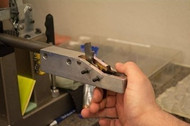Opening Shot
Posted by Timney Triggers on Oct 31st 2017
(The following is an article from American Rifleman's August 2009 issue.)
Crafting Success – One Trigger At A Time
Although upgrades such as a precision barrel, a custom stock, a trued receiver and bolt face and lapped locking lugs improve a rifle’s accuracy, one of the easiest and most economical yet often overlooked ways to improve performance is to simply replace the factory trigger. The premier manufacturer of easy to install, modular aftermarket triggers is Timney Mfg. of Phoenix, Ariz. But, the company’s rise to prominence was by no means a “walk in the park,” it was an “evolutionary process,” as John Vehr, current company president, described it.
Established in 1946 by Allen Timney, Timney Mfg. was founded upon replacement triggers for shooting enthusiasts sporterizing military Mausers, Springfields and Enfields a ripe market in the post war era. Such items remained the company’s bread and butter until Paul and Rosemary Vehr, Parents of the current Company president, purchased it in 1981.
Realizing that retirement was infeasible on only a pension. Paul first worked for General Electric, writing technical manuals for the Apollo program, then moved to Phoenix to work on avionics for Honeywell the Vehrs sought an alternate source of income in this case, investing in a promising company. Acting on the advice of a trusted business broker and, with Paul, a shooter, knowing the company’s reputation for quality, the couple decided to purchase Timney Mfg., literally, at a fire sale. Although it would prove to be a wise decision, it would take several years, rebuilding a bit at a time, to turn a profit. Most parts were discarded due to fears that the heat treating had been compromised; however, nearly all of the original drawings were saved, and half of the tooling was usable.
The Vehrs’ son John on of 10 children began working in his family’s facility in 1994, at the age of 31. “In my mind, I envisioned how a trigger was made, “said Vehr, recollecting the past; however, upon entering the business for the first time, reality set in. “It was a sweatshop with really old machines some of which had plaques stating, ‘Property of the War Department’ (Precursor to the Department of Defense) oil slicked floors, and other hazardous conditions,” recounted Vehr.
For the elder Vehrs, both of whom were products of the Great Depression era, quality wasn't as important as quantity... and income. But John thought differently, and proclaimed such to his parents. Nearing retirement age, John's parents were ready to relinquish the business, not change business models.
So, after having the business appraised, John began negotiating the terms of sale with his dad in 1999, providing enough income for a comfortable retirement. Unfortunately, three days after the 2000 Shooting, Hunting, Outdoor Trade (SHOT) Show, John's mother passed away. Five weeks later, while John was in Germany on business, his father died. The contract remained unsigned on his desk. Ultimately, John decided to continue with the purchase, buying it from his siblings for the original contract price.
"When I bought the company there were 15 workers in an area 20 percent the size of the space occupied now, and the remaining room was rented," recalled Vehr. "The business was labor-intensive, and regardless of how skilled the laborers, using manually operated machines the scrap rate was .005 percent. Although that sounds good, considering there are 25 different operations, by the end of the process approximately 88 out of every 100 units are good. That's horrible!"
"It took some time, but I got past the quantity vs quality model I inherited in purchasing the company," said Vehr. "It was time for a shift in focus, with quality becoming foremost important Quality was everything!"
Through the next few years' time, John invested heavily in technologically advanced machinery and the skilled labor necessary to operate it, thereby significantly reducing the payroll i.e. machinists and scrap rate, all while increasing quality. For example, although the company's water jet cutter, which used water and garnet abrasives at 40,000 p.s.i., could perform intricate cuts at a rapid pace, secondary operations requiring human interaction to finish materials further slowed the process, not to mention introduced variances that lessened consistency and quality.
For these reasons, Vehr purchased Wire EDM (Electrical Discharge Machining) equipment, as well as CNC (Computer Numerical Control) machines that, although slower, held previously unheard of tolerances according to Vehr, the Wire EDM holds tolerances within several millionths of an inch thereby minimizing the need for secondary operations. In fact, outside of programming the equipment, drilling and chamfering a few holes, assembly and testing, there's no human element in the manufacturing process.
Quality is further maintained through the in house manufacture of nearly every major component the exceptions being the safety plates and Ruger Mark II triggers, the latter of which are cast by Pine Tree Castings and then finished in house. Advanced Metal Finishing performs all of the metal coating.
Batches of aluminum and steel are pretested for consistency prior to taking shipment, and the metallurgical makeup and hardening-case-hardening vs. through-hardening-are application specific. For example, the AR's (AR-15 and AR-10) semi-automatic operation and high round-count probability require that tool-grade steel be used for parts. The hammers are made from S-7 shock-resistant steel, and the trigger shoes and disconnectors are from A-2 steel. All steel AR parts are through-hardened to a Rockwell hardness of 60.
Bolt-action rifle triggers, however, are cut from mild steels and are case-hardened. These, too, are hardened to 60 Rockwell. All housings are made from 6061 T6 aluminum.
Of the triggers Timney Mfg. builds, the most popular is that for the AR-15, constituting three out of every 10 units sold. In the realm of bolt-actions, the Mauser still reigns supreme, with more than 7,000 sold each year; however, the Remington Model 700 is nipping at its heels. Hefty quantities of Winchester Model 70, Ruger Mark II, Weatherby Mark V and CZ 550 triggers are also requested. The newest trigger is for the Ruger 10/22, and with the demand for aftermarket upgrades for the .22 LR platform, stands to be a top seller.
Triggers range from $50 to $260, depending on the model, and come with installation instructions. For those who prefer an expert to install the trigger, the firearm can be sent directly to Timney for installation, at a nominal cost, of course. Timney Mfg.'s triggers are available from a host of companies, including MidwayUSA, Brownells and Cabela's, to name a few; however, by purchasing factory-direct, the exact poundage desired can be preset at the factory. Regardless of place of purchase, every Timney trigger is mounted on a barreled action and tested extensively before being shipped.
Visiting Timney Mfg. recently, I noted a scrupulously clean manufacturing facility with few employees and a handful of large, precision machines. "Aaron, remember when I told you how I envisioned triggers were made before entering the business in 1994? About two or three years ago the vision came true. This is how I envisioned it," said Vehr. Interestingly, so did I.
The story of Timney Mfg. illustrates not only an evolution of a company, but also a mindset. By investing in the most technologically advanced equipment and talented personnel, and changing focus to quality rather than quantity, the end result is an American-made product that sets the standard in the aftermarket-trigger arena.

